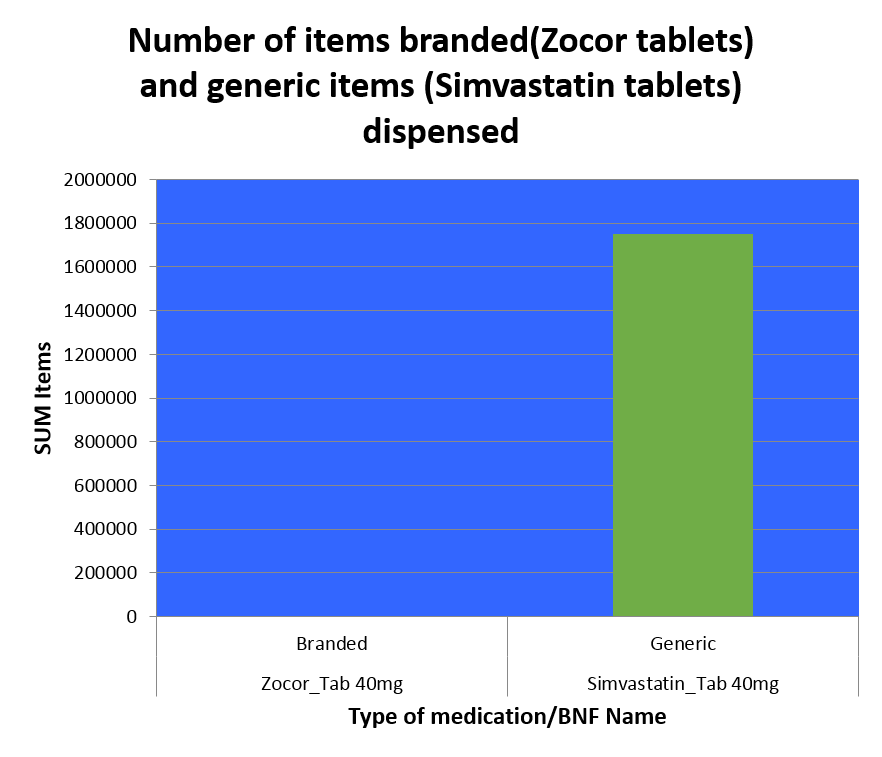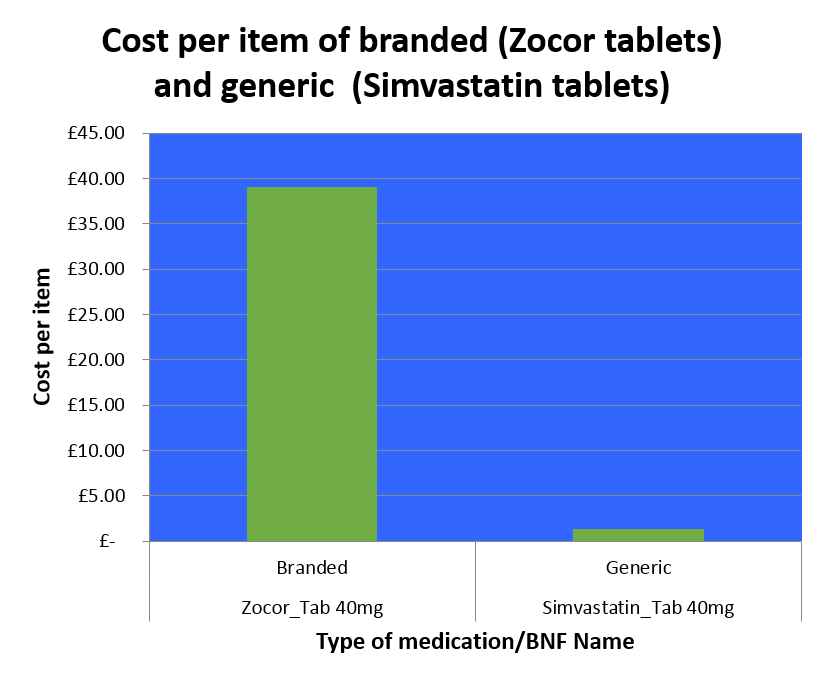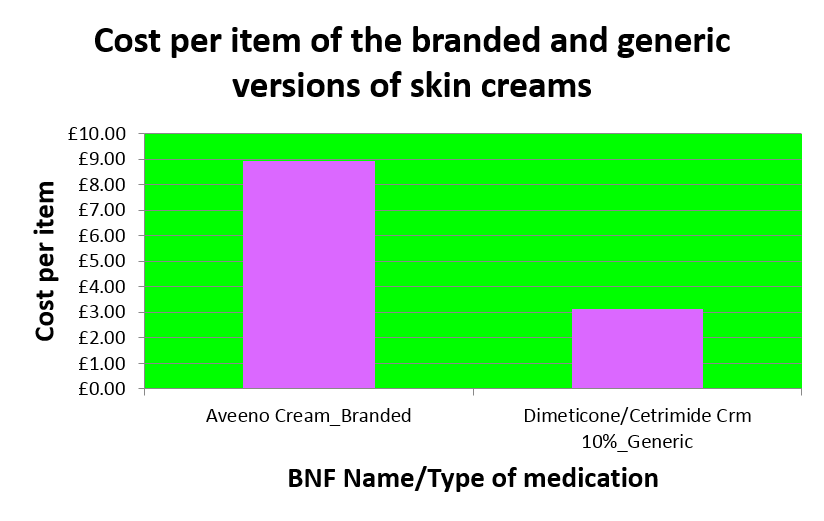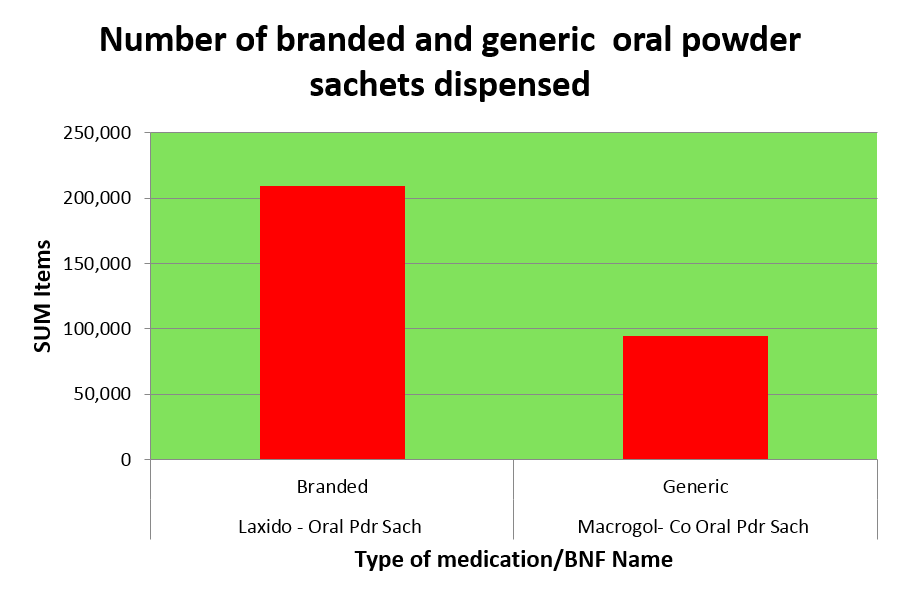Branded and Generic medication compared
According to the Office of Health Economics for the Association of the British Pharmaceutical Industry (ABPI), the total medicines bill in the UK was £13.6 billion in 2011 and £10.8 billion of this was spent on branded medication. Prescribers such as GPs are encouraged to prescribe generic medicine instead of its branded version. This is because, as stated by NHS Choices, generic medication can cost up to 80% less than branded medicine, whilst still being as effective. With this in mind I have enjoyed comparing the number of items and the cost per item of the branded medication and its generic alternative dispensed by GP practices in the UK.
Findings:
This is evident as Figure 1 shows the number of items of the branded medication called Zocor tablets 40mg that were dispensed, and the number of items of it’s generic version called Simvastatin tablets 40mg that were dispensed in August 2014. The generic medication was dispensed at a much higher rate than it’s branded alternative. This is evident as there were 1,748,989 Simvastatin tablets dispensed, compared to the 345 Zocor tablets that were dispensed. These tablets are used to reduce levels of low-density lipoprotein and increase levels of high-density lipoprotein.
Figure 2 shows the cost per item of Zocor 40mg tablets and its generic alternative called Simvastatin 40mg tablets that were dispensed in August 2014. It shows that the branded medication was a lot more expensive than the generic medication. This is apparent as the branded item, Zocor 40mg Tablets cost £39.10 per item, while the generic item, Simvastatin 40mg tablets only cost £1.33 per item. Figures 1 and 2 illustrate how general practioners often dispense more generic items than branded items to reduce the expenditure pressure on the NHS as they show that the cheaper generic version of the medication was dispensed more than the expensive branded version.
Figure 3 shows the number of branded and generic items of skin creams dispensed in March 2014. It shows that the branded medication, called Aveeno cream, was dispensed to a much larger extent than its generic alternative, called Dimeticone/Cetrimide cream 10%. There were 72,597 items of Aveeno Cream dispensed, whereas there were only 170 items of the generic version dispensed.
These creams are used to prevent and treat dry skin.
Figure 4 is the cost per item of the branded and generic versions of skin cream. It shows that the branded cream, Aveeno Cream was more expensive than the generic version called Dimeticone/Cetrimide cream 10%. The branded medication was about £5 more expensive than the generic as Aveeno Cream costs £8.92 per item while Dimeticone/Cetrimide cream cost £3.14.
Patients trusting the branded medication that they are used to over the newer generic versions could affect this, and the doctor may be likely to give in to their requests.
Figure 5 shows the number of branded and generic versions of oral powder sachets that were dispensed in August 2014. The branded version is called Laxido oral powder sachets and the generic version is called Macrogol Co oral powder sachets. The branded version of the medication was dispensed over 2x’s more than it’s generic alternative. This is evident as there were 209,449 items of Laxido oral powder sachets dispensed, compared to only 94,864 items of Macrogol Co oral powder sachets. This medication is a laxative used to treat patients who have had long-term constipation.
Figure 6 shows the cost per item of branded and generic versions of Oral powder sachets in August 2014. It shows that the branded medication was half the price of the generic version. This is evident as Laxido Oral Powder Sachets cost £5.78 per item, whereas Macrogol Co Oral Powder Sachets cost £10.80 per item. When looking at Figures 5 and 6 together they show that the branded medication was cheaper than the generic and was dispensed more than the expensive generic version.
The table below summarises the data on the number of branded and generic items dispensed and the ratio for each of the medications I looked at, as well as the cost per item and the ratio of that.
| Number of items | Cost per item | |||||
| Branded/Generic | Branded | Generic | Ratio | Branded | Generic | Ratio |
| Aricept/Donepezil | 54 | 90669 | 0.000596 | 57.09 | 1.25 | 45.67 |
| Celluvisc/Carmellose | 18499 | 1379 | 13.42 | 11.57 | 12.51 | 0.93 |
| Panadol/Paracetamol | 24 | 1436494 | 1.67E-05 | 5.39 | 3.35 | 1.61 |
| Piriton/Chlorphenamine | 4760 | 61822 | 0.08 | 0.86 | 1.7 | 0.51 |
| Yasmin/Ethinylestr | 38420 | 9236 | 4.16 | 22.6 | 22.3 | 1.01 |
| Aveeno/Dimeticone | 72597 | 170 | 427.04 | 8.92 | 3.14 | 2.84 |
| Pancrease/Pancreatin | 96 | 1 | 96 | 111.63 | 33.3 | 3.35 |
| Zocor/Simvastatin | 345 | 1748989 | 0.000197 | 39.1 | 1.33 | 29.40 |
| Laxido/Macrogol | 209449 | 94864 | 2.21 | 5.78 | 10.8 | 0.54 |
| Zaroxolyn/Metolazone | 4 | 619 | 0.01 | 95.62 | 2 | 47.81 |
| Seroquel/Quetiapine | 113 | 17893 | 0.01 | 95.62 | 2 | 47.81 |
| Prograf/Tacrolimus | 2454 | 410 | 5.99 | 81.77 | 81.8 | 1.00 |
| Voltarol/Diclofenac | 155 | 1716 | 0.09 | 17.73 | 12.78 | 1.39 |
Conclusion:
I was expecting to find that the generic version would be cheaper and so dispensed more than the branded version of the medicines, and I did find this for a few medications. However I was surprised to find that there are medicines where the branded medication was dispensed more than generic alternative even though it was more expensive, and that branded medication can be cheaper than it’s generic alternative. Also the absolute level of prescription for the different medication is interesting as there were only 72,597 items of Aveeno Cream dispensed, compared to 1,748,989 Simvastatin tablets. The difference could be because Aveeno Cream can be bought without a prescription and it is used for dry skin, whereas Simvastatin tablets can be used to lower cholesterol and risk of heart disease, diabetes and stroke.







Hi Leonisha –
Interesting post. Did you find a list of branded/generic equivalences, or were the mappings you used based on desk research of your own?
Something I keep wondering about is the distribution of manufacturer products. I don’t suppose you’ve found an open list that matches branded drugs to manufacturer/pharmaceutical company, have you?
Hi Tony,
Thanks for the comment.
In my first blog post I explained that each medication had a unique BNF Code and if the product is branded but had a generic alternative the 14th and 15th digit of it’s BNF code match that of it’s generic equivalent.
Therefore I filtered down the products to display the branded products that had a generic equivalent available. Then I did my own research on google for the generic version of the branded product.
No sorry, I haven’t been able to find a list that matches branded drugs to manufacturer/pharmaceutical company.
Hi Leonisha
Thanks for clarifying that… I never put the time into the prescribing data to be able to look at it in anyway sensibly, but your posts are giving me plenty of cribs for next time I do have a play:-)
And your last comment suggests a handy little function around the BNF: for a given formulation, get a list of branded/unbranded alternatives.
Thanks again:-)
Re: the manufacturers, some company names seem to appear in elements of TRUD > NHS Dictionary of Medicines and Devices > NHSBSA dm+d .
Hi Tony
Glad you’re finding my posts useful, and thanks for the link.